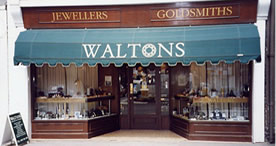WATCHES
The main thing about a watch is that it needs to tell the time accurately. This can be done in two main ways - Mechanical or Electronic.
Mechanical watches consist of 3 main parts: a mainspring to provide power, a regulator and a winder to wind the mainspring.
There are approximately 130 parts to a standard Mechanical watch and therefore it is necessary to protect them and have them regularly serviced. You should also avoid contact with magnetic fields as these can throw a Mechanical watch off balance completely. Watchmakers are continually developing new ideas and now there are Automatics, Chronographs, Alarms and Chronometers to name a few.
An Automatic watch has 2 major advantages against the mechanical:
1. The wearer doesn’t need to remember to wind it everyday.
2. The wearer’s movements keep the watch fully wound therefore allowing accurate time keeping.
Modern technology has made it possible to programme the leaps years and moon phases into a watch but some people want even more - these developments are known as ‘grande complications’. A good example in this is Patek’s Calibre 69, an astronomical watch. It has 33 functions including chronograph, minute repeater and alarm. It takes 4 years to assemble its 1,728 parts.
Battery watches - With fewer working parts and constant vibrations from the luterial crystal they can be guaranteed accurate to within a few seconds a year. But the battery does need changing about once a year.
Manufacturers are keen to develop longer lasting batteries to combat this. Two Japanese firms have decided not to use batteries at all. Seiko Kinetic uses the wearer’s arm movements to generate electricity in much the same way as an Automatic watch. This watch however, is so efficient it can keep going without being worn for 14 days. The Citizen Eco-Drive uses light power, which falls on cells that in 1 minute can take up enough power to run the watch for 24 hours! This watch will operate for up to 7 days without sun exposure.
Water resistance - The usual limits are 3 atmospheres (30m), 5 atms (50m) and 100 atms (100m). It is important to remember that if the back of a water resistant watch is removed it can no longer be guaranteed unless the seal is replaced and the back put on by a qualified person. Watches actually intended for serious diving should be regularly checked over for accuracy. The main benefit for a water-resistant case is that it protects the movement from dust - especially important in electronic watches. The only accepted description of a watch cases, today, is water resistant, waterproof is no longer accepted.
The most popular material for watches now is stainless steel, as real gold is slightly too soft for every day wear and gold-plating wears off gradually. Most steel backs can also carry the brand’s identification number and other useful information, such as degree of water resistance.
Dials are mostly made from metal, these can be turned, coined and engraved and the details printed, painted onto enamel or applied to a solid silver base by tiny screws. Some even have the hours picked out in tiny diamonds !!!
Figures are usually picked out in Arabic or Roman numerals and the hands are also an important part of the design, they must blend with the figures on the dial and the overall design.
The watch glass can be made from one of the following materials:-
1. Acrylic plastic- A hard wearing compound that will not yellow with age and can be moulded cut or injected.
2. Mineral glass- A natural glass chemically hardened to form a hard outer coating that is resistant to scratches and shocks.
3. Sapphire crystal- A man-made stone that is virtually scratchproof and is used in the best watches, particularly those with see-through backs.
At the other end of the scale from fashion watches are the Dress watches. Many men and women like to wear a different watch during the evening from their everyday model. For men, a slim gold or gold plated model is usually seen as suitable for evening wear and for women, there is a hugely diverse choice ranging from, watches with interchangeable straps or bracelets to watches set with many precious stones.
SERVICING YOUR WATCH
A watch is unique in that it is expected to perform 24 hours a day, every day to a degree of accuracy that no other piece of common use equipment does.
A mechanical watch will need a service every 2 years and an electronic one will need a battery.
A new strap will brighten up a tired looking watch no end, they are available in a wide variety of textures and finishes including lizard, crocodile, calf and mock versions of these too.


